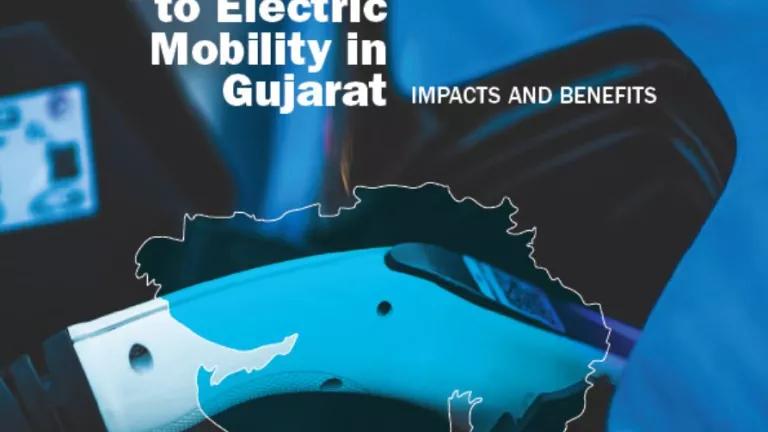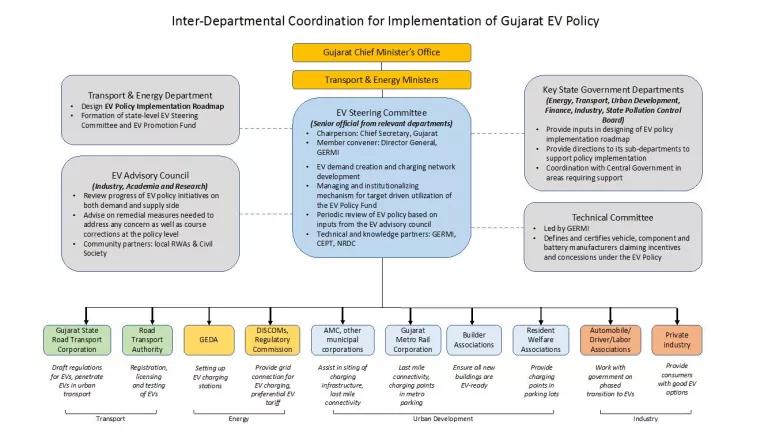Moving to Electric Mobility in Gujarat: Impacts, Benefits

Co-authored with Charu Lata and Jessica Korsh
With plans for new lithium-ion battery factories in Indian states, such as Gujarat, state electric vehicle (EV) policies are increasingly important to grow the nascent market. Electric mobility is an emerging priority for national and state governments in India and around the world. Shifting to electric vehicles is a major opportunity for economic and job growth, improved air quality, reduced carbon emissions. EV sales need to drastically increase to advance electric mobility in India by 2030.
While Gujarat is a slated to be a lithium-ion battery hub, the state has yet to issue a final EV policy. A Gujarat State EV policy would send clear market signals to advance EV policies for both supply and demand as well as keep up with market trends nationally and globally. The EV market and related industries, such as batteries, would reap the economic, environmental and societal benefits as part of and following with COVID-19 economic recovery.
Over 15 states in India have final or draft EV policies that support the national electric mobility policies. Gujarat initiated a draft policy in 2019 and the state has made progress on transportation electrification. The draft Gujarat EV Policy aims to sell 100,000 EVs, approximately 7% of overall sales, over a three-year period. The policy also provides incentives for charging stations and manufacturing.
Gujarat has emerged as an investment destination for major automobile players. The state is on course to become India’s leading auto hubs in the next few years and presents tremendous opportunities in automobile and component manufacturing. Gujarat is uniquely poised to leverage its strength as a growing auto hub in the global shift towards EVs.
A new report, Transitioning to Electric Mobility in Gujarat - Impacts and Benefits. examines the transportation market in Gujarat, the status of electric mobility adoption in the state, and the potential impacts of the draft Gujarat EV policy. The report addresses job growth; co-benefits for the environment, air quality, and energy security; and challenges to EV deployment. The report also includes key takeaways based on research and analysis of the EV market and makes the business case for the adoption of a strong EV policy in the state of Gujarat. The report is prepared by the Gujarat Energy and Research Management Institute (GERMI) and CEPT University along with NRDC.
The 10 takeaways from Transitioning to Electric Mobility in Gujarat - Impacts and Benefits are:
- Need for a Gujarat Electric Mobility policy. Shifting to electric vehicles will have major economic, environmental and social benefits in Gujarat. To keep up with market trends, Gujarat should formally release its EV policy, while national policies continue to evolve. A state policy with clear targets can continue to be tailored while highlighting Gujarat’s priority on EV for economic growth and environmental goals.
- Significant economic opportunities with clean air and climate benefits. The Gujarat EV Policy would achieve 2 billion clean vehicle kilometers, accounting for reduction of 0.3 million tons of CO2e emissions; save 98 million liters in terms of oil import (petrol and diesel) and reduce consumption of 26 million kilograms of compressed natural gas; and lead to savings of more than ₹2 billion ($27.4 million) in terms of avoided emissions over the projected three-year period of the draft policy.
- Job creation and “Make-in-India” opportunity. With a large automotive manufacturing base in Gujarat, the adoption of e-mobility will introduce new high-skilled jobs in the manufacturing of batteries, EV powertrain, components, and charging infrastructure. The additional consumption of electricity will in turn create jobs in the power and renewable energy sector. Gujarat can demonstrate leadership to grow its EV market and create jobs by investing in high-end technology, securing a local supply chain from the start, and providing a complete mobility solution, not just a vehicle. This will boost and instill confidence in the local automotive industry, as well as align well with the national Make-in-India campaign.
- Strengthen inter-departmental coordination. A planned and structured implementation is key to achieving the targets specified under any policy. Clarifying inter-departmental coordination will serve to streamline policy implementation and advance EV deployment. A state-level EV Steering Committee can provide the structure for departments including Gujarat State Road Transport Corporation, Road Transport Authority, Gujarat Energy Development Agency (GEDA), power utilities, city municipal corporations among others to plan, implement and modify the EV policy (See Figure 1).
- Enhance distribution company (DISCOM) engagement. Develop utility EV programs and policies that advance electric mobility, allow for streamlined EV grid infrastructure investments, grid connections, land availability, and ensure attractive and stable tariffs for EV. Frontloaded investments into charging infrastructure and the EV grid by utilities can lead to large pay-offs in the long term, as is being quickly recognized in many US states, Europe and other international examples.
- Encourage partnerships with business and civil society. To leverage limited government resources, developing partnerships with businesses, OEMs, academic institutions, civil society, are crucial to grow the electric mobility market.
- Incentives to grow the EV market. To maximize the economics of electric mobility, Gujarat can introduce policy interventions at the state- and city-level such as additional incentives for using clean energy for EV charging and setting up a single window clearance system to attract investments for “Ease of Doing Business”. These incentives would aim to create a critical, self-sustaining mass of EVs, manufacturers, service providers and stakeholders.
- Strong and integrated city actions on electric mobility. Congestion pricing and other non-fiscal incentives such as mandatory procurements of EVs by state agencies, reserved parking spaces, and low emission zones in major cities can enhance EV adoption as well as improve air quality and traffic congestion. Updating the General Development Control Regulations (GDCR) to account for charging points in housing societies, commercial establishments, and shopping complexes is also critical.
- Expedite land identification and availability. Gujarat can facilitate land for charging infrastructure through incentives, such as long-term leases and lower interest rates. A database of suitable and available land in the major cities of Gujarat may be developed after due verification from the respective authorities. Standard Operating Procedures can be developed for deploying public charging infrastructure, and periodic evaluation of its performance.
- Focus on freight electrification. Gujarat can take a lead on EV freight vehicles (medium- and heavy-duty) given the high-level of industrial and commercial activity, especially around ports and dedicated industrial zones. Specialized pilots and use-case specific strategies may be developed for transitioning Gujarat’s commercial fleet to EVs.

It is an opportune time for Gujarat to transition to future oriented technology through a state EV policy. As it is already showing with batteries, EV manufacturing will open new opportunities across a range of products and services, such as EV components, batteries, EV chargers and charging infrastructure. This will attract investments in the state to secure the supply chain through domestic manufacturing, reduce the dependence on vehicle and component imports, and develop the ecosystem for in-house manufacturing to align with the “Make in India” campaign. The renewed focus on innovation, design, development and competitive local manufacturing can meet the domestic demand and allow Gujarat to become a global leader while also driving domestic EV demand leading to cleaner cities and jobs.
Charu Lata is a clean energy expert working with NRDC as a consultant based in New Delhi. Jessica Korsh is a former NRDC Duke Stanback Fellow.
Highlighted NRDC and partner publications on electric mobility in India:
- Financing E-mobility in India: Stakeholder Driven Solutions
- Economic and Policy Drivers for Electric Vehicle Charging Infrastructure in India – Preliminary Analysis
- Scaling-Up Electric Vehicle Charging Infrastructure: Lessons from China and the United States for the Indian Context
- Location Is Everything: Approaches to Siting Electric Vehicles in India
Update: Here is the modified link to the new report Transitioning to Electric Mobility in Gujarat - Impacts and Benefits.
